The Challenge
Grassland birds have suffered the greatest decline of any terrestrial guild since the 1970s. Similarly, pollinators, which rely on wildflowers abundant in grasslands, have undergone dramatic reductions in population and diversity as the stresses of climate change and habitat loss have had deleterious impacts. Grasslands are also important carbon sinks, storing 150% more carbon below ground than temperate forests. The project funds conversion of non-native cool season grasslands that are maintained by mowing to native warm season grassland maintained by fire. Native grasslands support more wildlife species and store considerably more carbon than cool season grasslands. Prescribed fires do not contribute to overall CO2 emissions because carbon released during burning is reabsorbed over short periods of time as new vegetation grows, in fact burning accelerates storage of below ground carbon. Management through prescribed fire also reduces the need for mowing and associated emissions. Restoring degraded grasslands to healthy native grasslands has been identified as a key strategy to increase global carbon sequestration while promoting habitat for many common and declining species.
Project Scope
This project is focused on restoration of native grasslands on state Wildlife Management Areas in the Quaboag River Valley. The goal of the project is to initiate restoration on 80 acres of native grassland in the Quaboag and Richardson WMAs, and to purchase equipment that would allow MassWildlife staff to harvest and plant seed from state lands. The restored grasslands will provide important habitat for declining wildlife impacted by climate change. Unlike above ground carbon stores, the carbon stored in the soil is less vulnerable to perturbations such as storms, pests, pathogens, wildfires, and other major disturbances. The project is also a demonstration of native grassland habitat that can be replicated on other WMAs where cool season grasses are maintained through mowing. The purchasing of harvesting and planting equipment allows for more efficiency, flexibility, and the ability to harvest a diversity of native ecotype plant seeds.
Metrics
The project objectives are initially measured by acres treated. MassWildlife will continue to monitor the success of native grass establishment.
Results
The goals were all achieved during FY24. Harrowing and seeding were completed during May and June. All target fields were planted with little bluestem, the dominant native warm season grass. In some fields, 100% of the cool season grasses were converted, and in some areas, founder strips were installed to maintain wildlife cover as the native grasses become established. Herbicide treatments were conducted in May on portions of the WMAs by MassWildlife staff to facilitate conversion. Prescribed fires were conducted on June 3 and 11 on the Quaboag and Richardson WMAs respectively. Total acres burned were 70 acres. Ten acres of unburned grasslands at the Quaboag WMA were harrowed and seeded in June. Early monitoring observed good seed germination.
Best Practices and Lessons Learned
The biggest challenge is related to the state’s fiscal year constraints. Ideally, a project like this would have a multi-year timeline. Spring seeding can leave seedlings vulnerable to summer droughts, so supplemental seeding may be required. MassWildlife also adapted the strategy for firebreaks in restoration grasslands. Now a ring of cool season grasses is left around the exterior edge of the fields to reduce fire behavior along the firebreaks and decrease firebreak maintenance. The project also needed to buy some additional equipment adapters so that the harvester could be used with a variety of tractor models. Overall, the projects were very successful, and MassWildlife has begun scaling up and replicating the model to other wildlife districts and WMAs.
Project Alignment with ResilientMass Plan Priority Actions
This project contributes to the following normative frameworks related to climate change resilience and biodiversity conservation:
- Implement the “Forests as Climate Solutions Initiative”, to ensure Massachusetts’ forests are managed to optimize carbon sequestration and mitigate climate harms – Increasing carbon storage in grasslands.
- Implement EEA’s Resilient Lands Initiative and incorporate the Healthy Soils Action Plan and other statewide land and water management plans. – Improving soil carbon storage and productivity for wildlife
- Develop a statewide approach and collaborative efforts to preserve and enhance forest and ecosystem health and conservation to enhance resilience and provide carbon sinks for GHG mitigation, including coastal sources, grasslands, and wetlands. – Soil carbon storage and grasslands are identified as target sinks.
Resilient Lands Initiative (2023) - "Focus on Natural Carbon Storage and Climate Resilience"
Healthy Soils Action Plan (2023) - Priority Action 3. "Consider ways to preserve and increase existing soil organic carbon stocks and sequestration capacity..."
Clean Energy and Climate Plan for 2025 and 2030 (2022) - Goals 1, 2, 3, 5: 1. Protect NWL: Keep Natural Working Lands (NWL) as NWL to protect current capacity for ongoing and future carbon sequestration. 2. Manage NWL: Enhance carbon sequestration and improve ecosystem resiliency to reduce risks of carbon loss from climate change and ecological disturbances. 3. Restore NWL: Reduce emissions and increase carbon storage capacity in NWL. 4. N/A 5. Explore additional carbon sequestration: Achieve net zero GHG emissions by 2050 with carbon dioxide removal and storage beyond the capacity of Massachusetts NWL.
Cross Governmental Action 5 - All actions implemented as part of the 2023 MA SHMCAP will evaluate the opportunity to reduce GHG emissions and when applicable will select options that have the lowest GHG emissions possible or provide the most carbon sequestration in the long-term. This includes considering the use of generators, pumps, and other common adaptation strategies and designing those strategies to reduce rather than increase emissions as well as land management activities to increase carbon sequestration and storage. Refer to the state agency actions, which are sorted by Priority Impact/Vulnerability, for additional actions the Commonwealth plans to take to address the goal.
Further Action
Planning has already begun on conversion of non-native cool season grasslands to native warm season grasslands on many WMAs. MassWildlife plans to convert at least 200 acres to native grasslands over the next four years using ResilientMass and other funding sources.
Additional Information and Resources
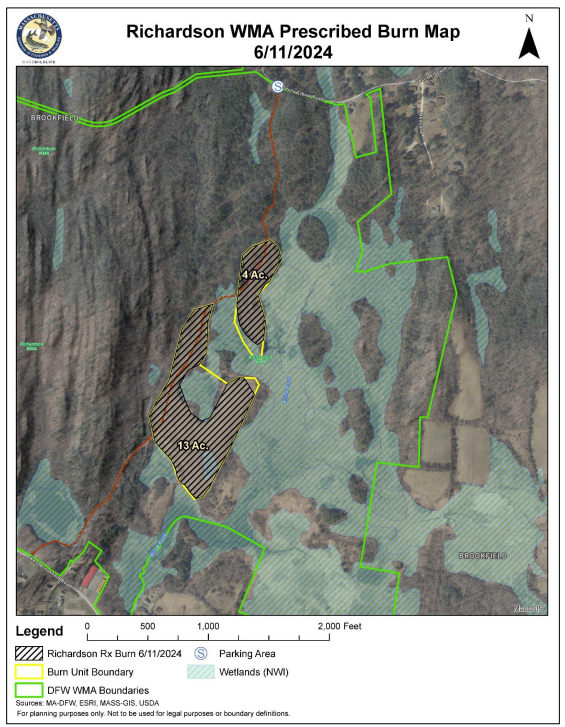
Richardson WMA Prescribed Burn Map 6/11/24
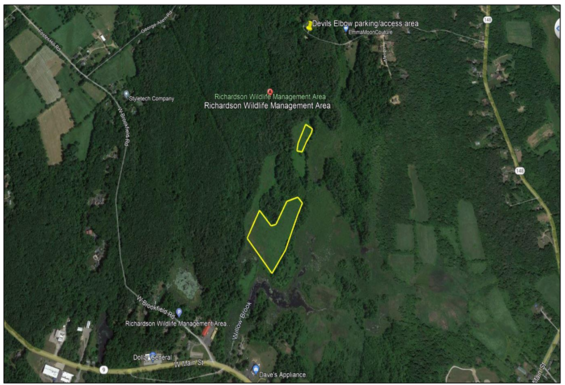
Harrow and seeding areas at Richardson WMA
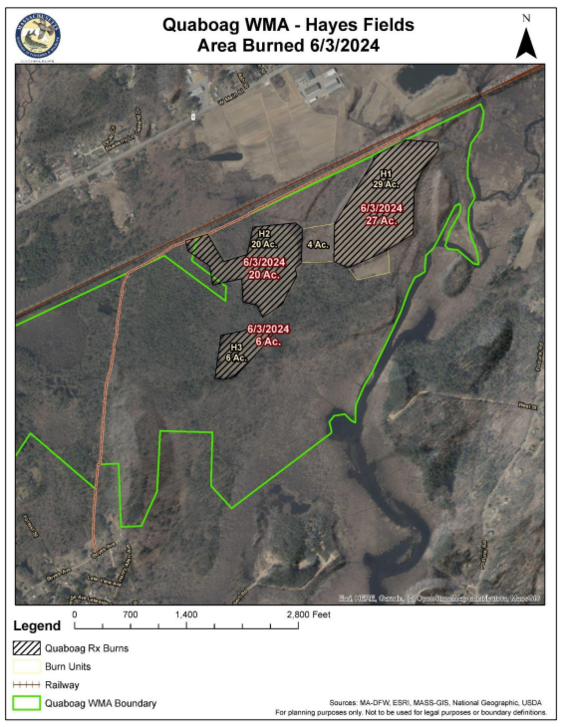
Quaboag WMA - Hayes Fields areas burned 6/3/2024
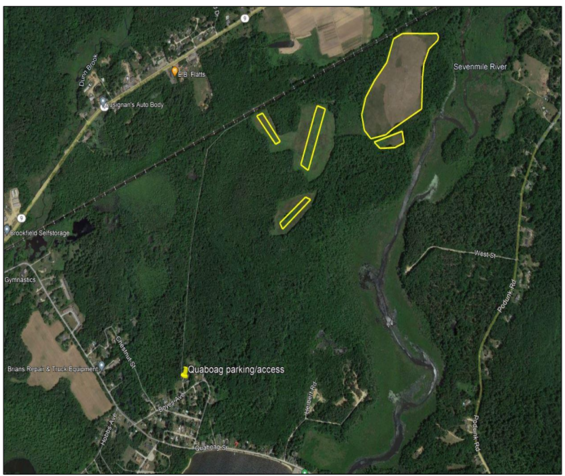
Harrow and seeding areas at Quaboag WMA (Hayes Fields)
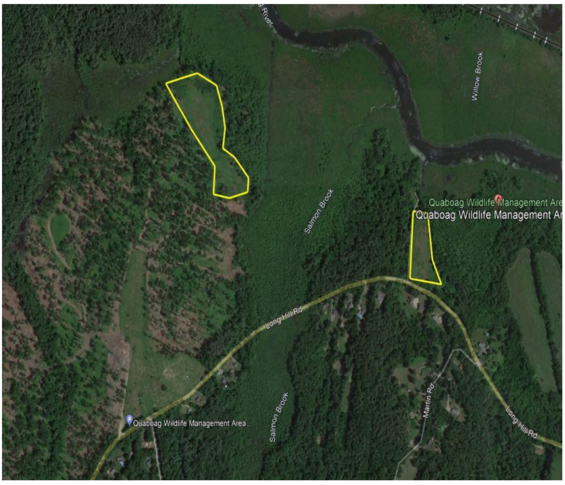
Harrow and seeding areas at Quaboag WMA (Long Hill Road)